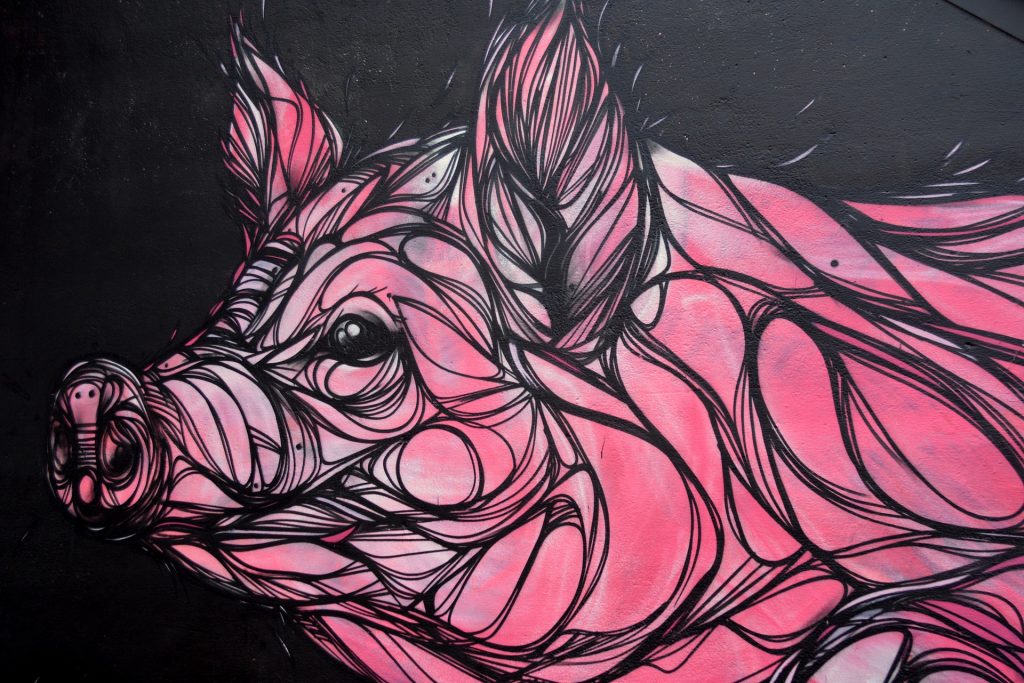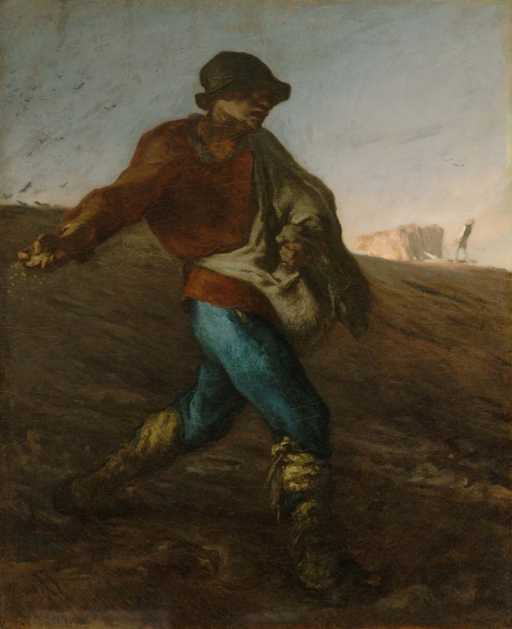From Paintings to Pig-Human Hybrids: Imagination and Our Interaction With Art And Science
Michael Stuart

When I get mad at my smartphone because it freezes, or when I plead with my car because it won’t start, I’m treating a non-human object as if it had beliefs and goals. This is mostly harmless, but in science it can obscure the truth. For Aristotle, rocks fell down because they were trying to get to the centre of the universe, and flames reached up to rise above the air. It took more than a millennium to overturn this natural way of thinking. Similar sentiments can still be found in scientific practice towards everything from molecules to economies.
I recently co-organized a conference with Fiora Salis to bring together philosophers of science and philosophers of art working on imagination. In this post, I want to explore an exchange that took place between a philosopher and a scientist during that conference.
The philosopher noted that we often need art critics to help us engage effectively with complex works of art. This marks a difference between art and science, the philosopher argued, since scientists don’t need “science critics.” In the question period, a scientist disagreed: Scientists can’t always digest new discoveries on their own, and something like science criticism is in fact necessary, and practiced.
The idea of science criticism is interesting. Philosophers have already noted similarities between art and science that would make plausible its necessity.[1] Still, it’s worth wondering 1) what good science criticism should aim to achieve, 2) who science critics are, and 3) how imagination is effectively mobilized by critics. To answer the first question we can appeal (by analogy) to art criticism, which does at least the following three things: describe, interpret, and evaluate a work.[2]
For example, a review by Jerry Saltz describes a painting by Kara Walker entitled Christ’s Entry into Journalism: It contains almost 100 figures, including Trayvon Martin’s head on a platter, and a member of the Black Panthers holding up the severed and swastika-engraved head of Donald Trump. Saltz interprets the painting in the following way. “Walker is reclaiming her name, essentially saying, I am an artist — not a ‘black artist’ — who is sick and tired of the long American night of racism and will now use my art as a weapon of mass destruction to attack it head-on.” Saltz also evaluates the work. It is terrifyingly beautiful, dark, mysterious, and magnificent. Perhaps science criticism should also therefore describe, interpret and evaluate.
Who are science critics? To name a particular group, I think science journalists describe, interpret and evaluate scientific work. For example, Sara Reardon writing for Nature describes how researchers used CRISPR gene-editing technology to insert human stem cells into pig embryos. Reardon interprets the meaning of this by drawing out some consequences and relating them to broader concerns: If successful, the development will provide new models for testing drugs and understanding human fetal development, and enable the creation of human-pig hybrids from a patient’s own cells to harvest bespoke organs. In other words, it’s a technical accomplishment that has implications for both theoretical and practical medicine. Finally, Reardon evaluates the work by noting that only a very low percentage of cells in the hybrid fetuses were actually human, and this percentage must be higher if we want to see the promises of the technique fulfilled.
So perhaps (some) science journalists are science critics. And like art critics, they facilitate our interaction with new breakthroughs by describing, interpreting, and evaluating them. Together, these critics provide a service that is important for the progress and public comprehension of art and science.[3]
What is the role of imagination in all of this? Good descriptions should assist our imaginations in conjuring up an idea of the work, if we have not experienced it, or bring it back forcefully to our attention, if we remember it only vaguely. Good interpretations will often engage our imaginations, as physicists used thought experiments to help interpret their theories.[4] But interpreting an artist’s work might simply mean placing that work in the context of a more general artistic trajectory or cultural milieu, while in science this might mean situating a discovery in the history of a lab’s ongoing efforts or the context of a theory. Critics and journalists can also influence how much we value a work, for example, by providing context,[5] revealing motivating intentions,[6] and explaining the techniques by which a work was accomplished.[7] Such techniques will not always draw heavily on the imagination. But critics and journalists do often engage our imaginations to help us find personal value in a work. They can do this by asking open-ended questions, posing puzzles, and offering suggestive metaphors that require us to imagine features of the artwork or scientific discovery in a way that will be relevant to our individual situation. Each of us might imagine something different, but the prompts can be the same.
For example, look at the painting below. It was completed two years after the February Revolution in 1848 in which Parisian peasants rose up against the increasingly conservative government. At the time, Parisian art tended to portray queens, kings, gods and goddesses, but Millet painted a humble peasant. Why? To transform a scene of “numbing, heartbreaking poverty and labour…into an image of epic nobility.”[8] Here are some questions that might help us locate personal value in the work: How do you think the peasant feels? The scene appears to take place in the morning, what do mornings represent for you? Why do you think the peasant is walking downhill? Why might Millet have chosen to obscure the peasant’s eyes? How do the colours make you feel?

While each of us will have slightly different answers (given our different personal histories), questions like these can help to clarify our feelings toward the work, which might reveal our attitudes towards peasants, working the land, class struggles and revolutions. This exercise can increase the personal value we find in the work for galvanizing, teaching, and inspiring us.
Exactly the same techniques work in scientific cases. The mental work of addressing questions, puzzles and metaphors can reveal to each of us the personal value of (e.g.) research into human-pig hybrids via questions like: Could this provide a cure to a disease that afflicts you or someone you care about? Do you think this kind of research is ethical? What else can CRISPR do? Where will medical research be in 5 years if this continues? Is CRISPR’s popularity drawing attention away from other methods that might deserve it more? By imagining answers to these questions we gain clarity on the importance of the research for our own lives. This is especially true for scientists, since the exercise can clarify how it bears on their work and whether it contains any new methods that could be adopted.
Questions, puzzles and metaphors can help us find value in a work by exploring its features and implications. What these prompts have in common is open-endedness; engaging with them forces us to imagine. This is important because no one can grasp the significance of a work of art or science for us. We have to do it ourselves.[9] I think this is an interesting conclusion. But it’s only a start. Whichtypes of imagination (e.g., propositional, objectual, active, sensory, etc.) are relevant for such exercises, and how exactly they facilitate the accumulation of personal value, requires more philosophical and scientific research. Given the analogy between art criticism and science journalism, perhaps the same kinds of imagination will be relevant for understanding and valuing both art and science, which could be philosophically fruitful. But there are also disanalogies that need to be examined. E.g., do artists require art criticism as much as scientists require science journalism?
This post explored some issues arising from the interaction of philosophers of art and science. I bet (and hope) that solutions, as well as further issues, will come from more such interactions.
Thanks to Margherita Arcangeli, Kiran Phull, Simran Phull, Fiora Salis, Julia Sanchez-Dorado, and Klaus Speidel for comments on this post.
(From THE JUNKYARD)
Notes
[1] See, e.g., van Fraassen and Sigman (1993), Bueno (2017).
[2] See, e.g., Beardsley (1958, 7-10), Cross (2017), and Grant (2013, 5).
[3] Having access to good descriptions, interpretations and evaluations of another’s work might not be necessary for a specific case of progress in science or art. But since science and art proceed by building on the ideas of others, it is unlikely that they could function as well as they do without this. Interestingly, critics and journalists can also hinder progress. Take for example the phenomenon of “hero worship,” where a community disproportionately focuses on the work of a certain figure. There are reasons to think this is epistemically dangerous. For example, it can lead to living legends who get all the attention and resources, and with these, shape their field. This causes ideas that do not cohere with the mainstream to be stifled. On the other hand, critics and journalists can help us see the validity and value of the work of non-heroes, and this can counteract hero worship by increasing open-mindedness and bolstering efforts to increase the diversity of ideas. Thus critics and journalists can aggravate or alleviate hero worship. This is a new route to a conclusion most of us already believe: critics and journalists have both ethical and epistemological responsibilities to use their power for good.
[4] Stuart (2016).
[5] Providing context helps us to see how a work breaks new ground. Without context, it can be hard to appreciate the innovation, bravery and hard work that went into something.
[6] For example, learning that Jonathan Swift’s “Modest Proposal” was written sarcastically in protest of the way poor people were being treated (anticipating The Onion by 259 years)can increase its value for us.
[7] For example, James Joyce’s Ulysses contains many sentences like the following: “Pineapple rock, lemon platt, butter scotch. A sugar-sticky girl shovelling scoopful of creams for a Christian brother. Some school treat. Bad for their tummies.” Many readers find this style frustrating. But passages like these represent a record of the protagonist’s thoughts and perceptions while walking through Dublin, which, in reality, wouldn’t be fully formed sentences. Explaining this can increase how much we value the novel. The same goes for science: We can increase someone’s appreciation of the value of a scientific breakthrough, even if its conclusion turned out to be false, by drawing attention to the innovative techniques it used.
[8] Robert Rosenblum, quoted in Brenson (1984).
[9] The idea that some epistemic states cannot be obtained through testimony and are better approached using open-ended questions, puzzles and metaphors was inspired by Alison Hills’s talk at the 2016 Summer Seminar on Understanding, part of the Capstone Conference for the Varieties of the Understanding Project, at Fordham University.
References
Beardsley, M. C. 1958. Aesthetics: Problems in the Philosophy of Criticism. New York: Harcourt Brace.
Brenson, M. 1984. “Gallery View; Why We Now See Millet Differently.” The New York Times, June 10.
Bueno, O. 2017. “Interpreting the Sciences, Interpreting the Arts.” In O. Bueno, G. Darby, S. French & D. Rickles (eds.). Thinking About Science, Reflecting on Art: Bringing Aesthetics and Philosophy of Science Together. London: Routledge.
Cross, A. 2017. “Art Criticism as Practical Reasoning.” British Journal of Aesthetics 57: 299–317.
Grant, J. 2013. The Critical Imagination. Oxford: OUP.
Olsen, S. H. 1998. “Appreciation. Encyclopedia of Aesthetics.” New York: Oxford.
Stuart, M. 2016. “Taming Theory with Thought Experiments: Understanding and Scientific Progress.” Studies in the History and Philosophy of Science Part A 58: 24-33.
van Fraassen, B. C. and Jill Sigman J. 1993. “Interpretation in Science and in the Arts.” Pp. 73-99 in G. Levine (ed.), Realism and Representation. Madison: University of Wisconsin Press.